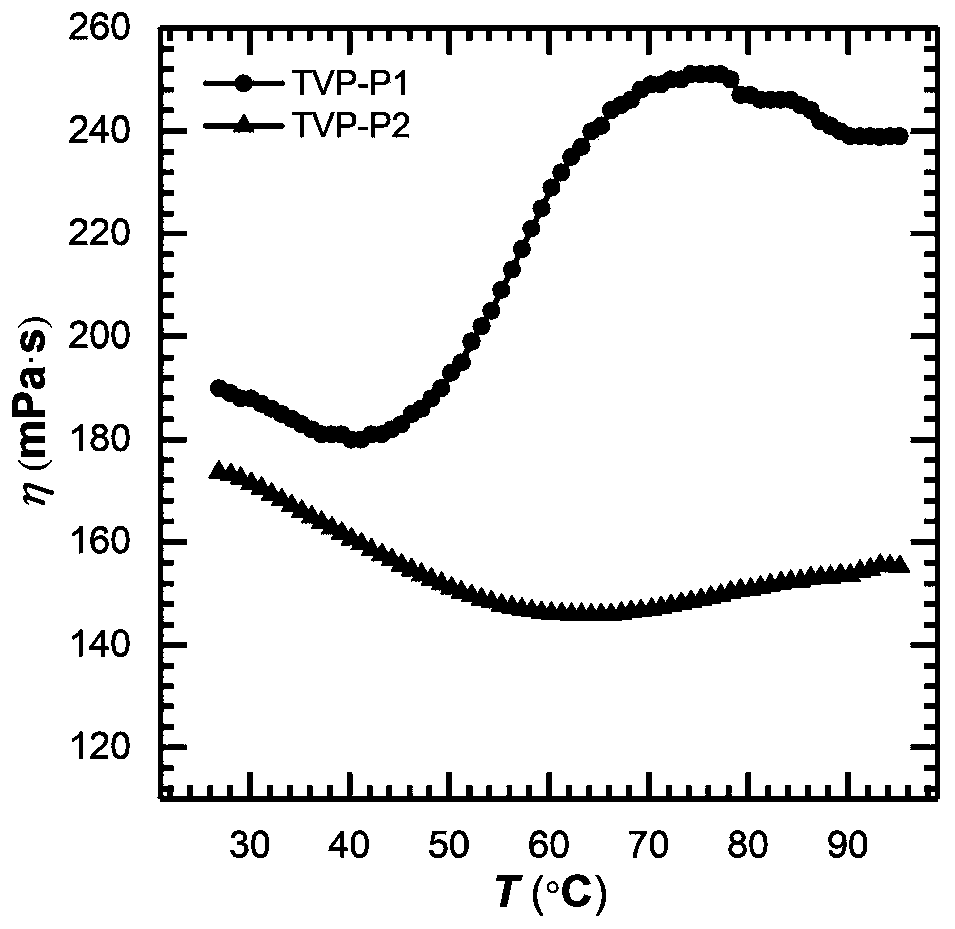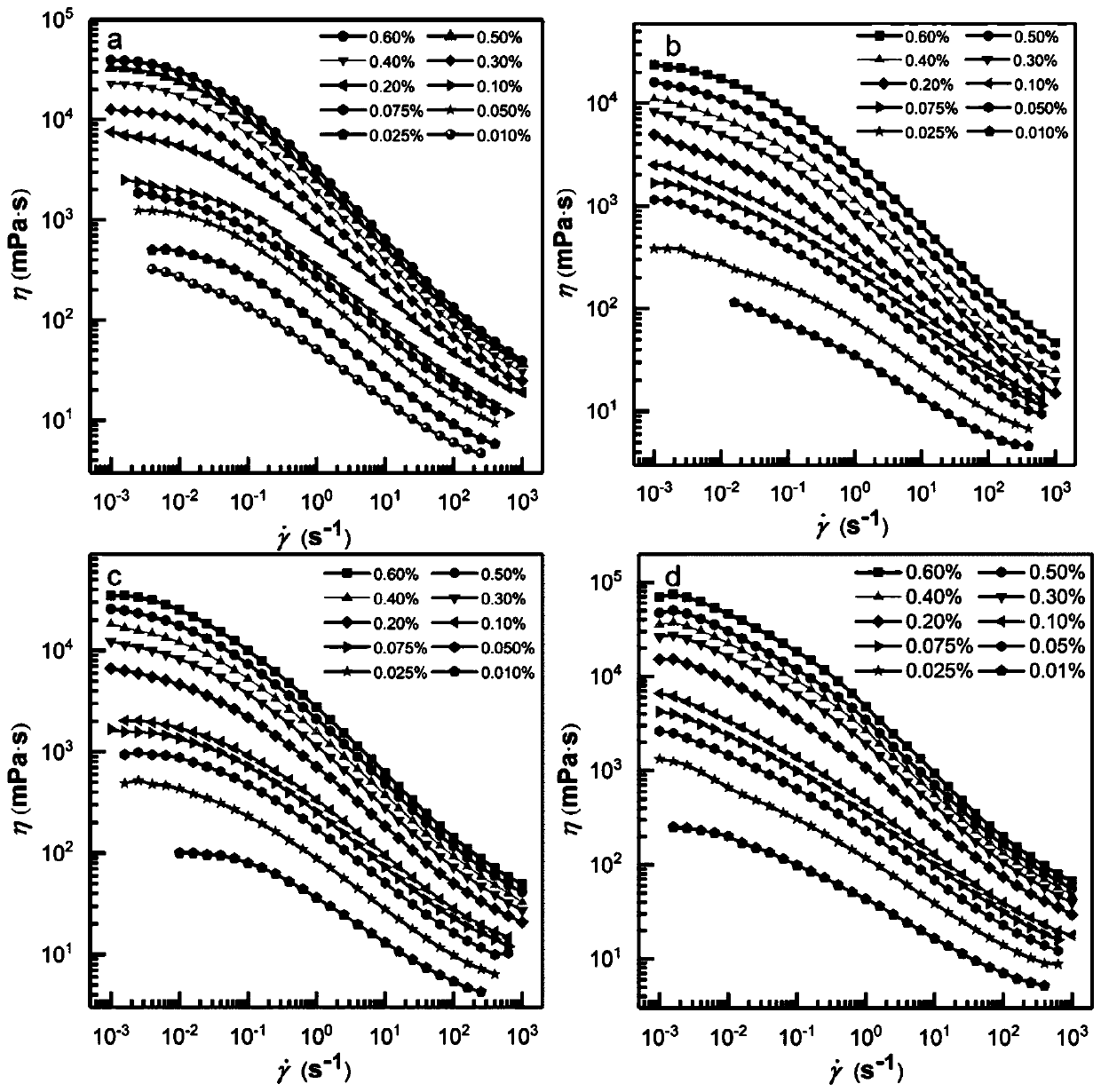A kind of anionic heat thickening water-soluble polymer and its preparation method and application
A water-soluble polymer, anionic technology, applied in the direction of drilling compositions, chemical instruments and methods, chemical/physical processes, etc., can solve the problems of high preparation and application costs, difficult post-processing, long dissolution time, etc. Achieve the effects of reducing application costs, improving production efficiency, and reducing dissolution time
- Summary
- Abstract
- Description
- Claims
- Application Information
AI Technical Summary
Problems solved by technology
Method used
Image
Examples
Embodiment 1-18
[0064] The following table explores the optimal inverse emulsion ratio from the four aspects of emulsifier type, oil-water ratio, monomer ratio, and the presence or absence of NaAA, so as to obtain the optimal anionic thermal tackifying polymer.
[0065] Table 1 Effect of emulsifier type on emulsion state
[0066]
[0067]
[0068] a × means no inverse emulsion was prepared, √ means inverse emulsion was prepared.
[0069] Table 2 Effect of oil-water ratio on emulsion state
[0070]
[0071] a × means no inverse emulsion was prepared, √ means inverse emulsion was prepared.
[0072] Table 3 Effect of monomer ratio on polymer properties
[0073]
[0074]
[0075] a × represents that the prepared polymer dry powder has no thermal viscosity-increasing property, and √ represents that the prepared polymer dry powder has thermal viscosity-increasing property.
[0076] Table 4 Effect of the presence or absence of NaAA monomer on polymer properties
[0077]
[0...
Embodiment 19
[0081] Dissolve 31.7% (w / w, the same below) of acrylamide, 9.5% of sodium acrylate, 8.6% of F127, and 5.0% of sodium chloride in 45.2% of deionized water, adjust the pH to 7.0, and prepare water Mutually. Dissolve 14.0% emulsifier HB246 in 86.0% mineral oil, heat to 50°C to dissolve, then add the oil phase and water phase to the emulsifier in sequence according to the ratio of mass ratio oil phase:water phase=4.5:5.5, Stir well and emulsify. After the emulsification is completed, transfer it to a 250mL four-neck flask equipped with stirring, nitrogen tube, and digital display thermometer, raise the temperature to 45°C in a water bath, and after passing nitrogen for a certain period of time, add the initiator AIBN, and start the polymerization. After the thermometer shows that the temperature rise is over, keep warm for 2 hours. The inverse emulsion ETVP-P1 of the anionic heat-thickening water-soluble polymer is obtained, and the obtained inverse emulsion is precipitated, was...
Embodiment 20
[0083] Dissolve 31.7% (w / w, the same below) of acrylamide, 9.5% of sodium acrylate, 8.6% of F108, and 5.0% of sodium chloride in 45.2% of deionized water, adjust the pH to 7.0, and prepare water Mutually. Dissolve 14.0% emulsifier HB246 in 86.0% mineral oil, heat to 45°C to dissolve, then add the oil phase and water phase to the emulsifier in sequence according to the ratio of mass ratio oil phase: water phase = 4.5:5.5, Stir well and emulsify. After the emulsification is completed, transfer it to a 250mL four-neck flask equipped with stirring, nitrogen tube, and digital display thermometer, raise the temperature to 45°C in a water bath, and after passing nitrogen for a certain period of time, add the initiator AIBN, and start the polymerization. After the thermometer shows that the temperature rise is over, keep warm for 2 hours. The inverse emulsion ETVP-P2 of the anionic heat-thickening water-soluble polymer is obtained, and the obtained inverse emulsion is precipitated, ...
PUM
 Login to View More
Login to View More Abstract
Description
Claims
Application Information
 Login to View More
Login to View More - R&D
- Intellectual Property
- Life Sciences
- Materials
- Tech Scout
- Unparalleled Data Quality
- Higher Quality Content
- 60% Fewer Hallucinations
Browse by: Latest US Patents, China's latest patents, Technical Efficacy Thesaurus, Application Domain, Technology Topic, Popular Technical Reports.
© 2025 PatSnap. All rights reserved.Legal|Privacy policy|Modern Slavery Act Transparency Statement|Sitemap|About US| Contact US: help@patsnap.com



